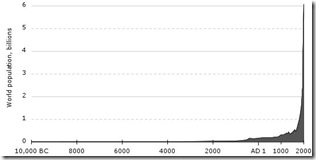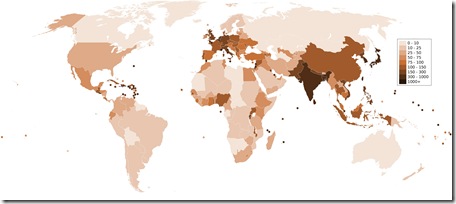All through this past week, I have been following the COP-15 negotiations towards addressing climate change. Climategate or no climategate, the data on the human contribution towards earth’s degradation (not just in terms of climatic abnormalities, or global warming but also increasing levels of toxic waste generation and pollution of the earth is various ways) almost conclusively attributes the current trends of environmental degradation to human activities. In the case of what is now referred to as “Climate Change”, i.e., global changes in weather patterns, increases in average annual temperatures etc, there seems to be clear evidence that human activities have significant contribution, if not being the sole contributor. So while all the governments of the world talk and negotiate for an acceptable climate pact that would balance economic needs of countries with mitigation of climate change effects, there seems to be precious little discussion on one factor that might be the real key to addressing the problem of anthropogenic climate change – population control.
Here is why I believe that controlling global human population is the key to saving the planet. Most of our population growth has taken place over the last 100-150 years. Current world population stands at 6.7 billion people with an average global density of 116 people per square mile. Even though population growth rates have stabilized over the past 50 years or so, the global population will still grow to about 9-10 billion by 2050. With this kind of crowding, I wonder how long the planet will be able to sustain the human race. Considering the self correcting nature of our planetary system, one would be smart to consider a Malthusian catastrophe of gargantuan proportions in the near future.
Figure: Global population from 10,000 BC to 2000 AD (Source: Wikipedia)
Consider this, the number of recorded epidemics in Asia stands at 31, with 12 having taken place over a period starting from the Black Death of China in 1334 to the 1994 Plague of Surat. The rest of the epidemics have happened in the last 10 years. Compare that to sparsely populated Australia, where the last major epidemic apart from the current swine flu happened in 1867 (http://en.wikipedia.org/wiki/List_of_epidemics). While I am interpreting this data rather simplistically (since there are many economic and social factors that influence epidemics), there is still an interesting trend here that intrigues me, the Asian boom in Epidemics coincides with the rise of the Tiger Economies, growth in the average earnings of a significant proportion of this region’s population providing them with increased access to better education, nutrition and healthcare. This region also happens to be one of the most densely populated region in the world. While still faulty in details, the reasoning here is simple. The denser a region’s population, the easier it is for an infectious disease to spread. Increased density and local over-population would also cause increased agricultural activity pushing farm animals into closer proximity to humans, thereby increasing the risk of infections jumping from animals to humans and then spreading through a population. After all, it makes evolutionary sense for an infectious agent to jump hosts when the density of the alternate host is higher and has a larger geographical spread than the main host. Besides, the physiologies of the current host and the alternate host aren’t that different, so the jump wouldn’t entail a total reworking of the infectious agent’s genome.
Figure: Global population distribution (Source: Wikipedia)
Over population has other ills besides the increased risk of a lethal epidemic. Major resource crunches already plague cities all over India. Chennai, Delhi and Mumbai have a perennial water shortage problem. The Yamuna has already dried to a level where the government is now sanctioning building projects on the river-bed. The Gangetic plains of Northern India are some of the most densely populated areas in the country, and this population pressure has already wrecked havoc with the river. Even with improved agricultural technologies, India and other overpopulated countries like it face the glaring problem of massive food shortages. Water shortage is a global problem that is set to overtake us in the near future. This is especially worrisome for a country like India that depends so much on annual rainfalls for its agricultural water. The burgeoning population has to have its needs met, and the industry is happy to oblige by damming rivers everywhere, cutting down and digging up forests for mining and industry. The pace of urbanization is fast reaching unsustainable levels in this country. The effects are all too evident around us, rural poverty – as the attention shifts towards the cities and their economic activity, shortage of resources in areas around the growing cities (Delhi gets its power mostly from hydro-electric projects in Himachal Pradesh and Uttarakhand), massive levels of pollution of all kinds and so on.
Over-population induced resource shortages are also the reason for conflicts among various social, economic, religious classes. More severe the shortages, the more virulent the conflicts become. The rise of identity based politics, I believe has its roots in this shortage of resources, that in-turn leads to the mass anger which is the fodder of all such movements. The religious and cultural chauvinism of the RSS and its ilk, and the effectiveness of grass-roots level Maoist movements lies in this mass anger and sense of unfair deprivation. When there is a competition for limited resources, there are bound to be winners and losers. It is in that competition, that the seeds of social injustice and social discord lie. India and China are both examples of societies polarized by this competition for resources. And as the pressure of population on the land grows in the coming years, this conflict will only get worse, till it becomes impossible for civil society and the state machinery to control the social unrest, and the fabric of civil society crumbles.
So, coming back to climate change and the state of the environment, any talk of reduction of emissions and controlling pollution is meaningless for countries like India and China when their governments have pressing social obligations to fulfill. They need to keep their economies growing till it includes at least a majority of their populations. Right now they are nowhere near that goal. The story is the same with other developing countries, except that they are worse off economically. For the climate endeavor to be meaningful, the problem has to be addressed with a systems perspective, and that involves addressing issues like global population control. Social and religious considerations aside, the world needs a concerted effort for controlling global population growth rates through an international program of birth control and population redistribution. Along with that, a shift in focus from “economic progress” to “progress in quality of life” is needed.
As world leaders meet in Copenhagen today for a final push at a climate agreement, I hope they have this in mind when they prepare their document – The biggest problem with the world is not how much we pollute (although that too IS a major headache), the biggest problem with the world, is how many of us are there. Otherwise, pretty soon, they won’t need to. Like all self-correcting complex systems, our planet will cause the relevant changes to bring itself to a stable equilibrium, while we will remain mute, helpless spectators to the process.
Edit (December 21st 2009): Just finished reading David J.C. MacKay’s book “Sustainable Energy – without the hot air“. It is a must read for anyone interested in climate change, sustainable energy and the economics of the global dialog on mitigation of the effects of climate change. I think, I now better understand the various involved parties’ differing views on this subject, why the talks nearly collapsed in between, and why the “compromise accord” brokered by Barack Obama is probably an eye-wash. If one looks carefully at MacKay’s numbers (and the whole book, thankfully, is all about the numbers), one gets a clear idea of two things.
1. The cost of alternative “sustainable” energy is too high even for a lot of developed countries to afford. They don’t come anywhere near the fossil fuels in terms of energy density and costs.
2. The ultimate cost of shifting to alternatives, even partially, is dependent on a country’s population.
There are other points too that are evident in the book, namely, the climate problem is basically a problem of energy, that nuclear power might be a good idea for the short- to medium term, the environmental cost of a number of alternatives (like Hydro-electric power) is high, and that a huge proportion of South Asia’s carbon footprint is on account of Western consumption.
So, the only way climate change can be seriously tackled is by the West to change its life-style and by the Asian countries to undertake serious population control measures. Apart from these, countries like India CAN work to reduce carbon emissions for the short term by legislating fuel efficiency in transport, investing more in public transport, giving incentives for energy conservation where-ever possible. A little policy innovation and political will is required here. At the same time, a sustained program of population control and re-distribution should be undertaken to ease the burden on currently over-populated areas across East Asia.

